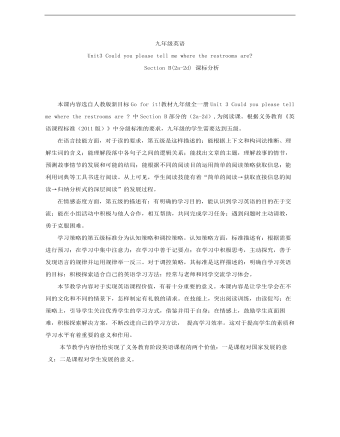人教版新目标初中英语九年级下册Could you please tell me where the restrooms are说课稿7篇
-
- 页数:29页
- 字数:约 28241 字
- 大小:479.50KB
- 格式:.doc
- 版本:Office2016及以上版本
- 作者:曼达林演示
Could you please tell me where the restrooms are说课稿7篇
Could you please tell mewhere the restrooms are?section A说课稿
一说教材
(一)教材的地位及作用
1、新目标英语教材概述
《新目标英语》教材的语言教育理念是:知识用于行动强调“语言应用”,培养“创新、实践能力”,发展“学习策略”。它采用任务型语言教学(Task-based Language Teaching)模式。教材中每单元都设计一个或几个与该单元话题有关的任务,让学生在完成任务的过程中,使用英语获取信息,用英语进行交流,培养运用英语解决实际问题的能力。

2、单元分析及教材的处理
本课是新目标英语九年级第11单元,教材以 Could you please tell me the restroom is ? 为中心话题,围绕着描述“一系列地点”展开,学习和运用有礼貌的询问方向展开,让学生学会谈论位置。本课教学内容与学生的实际生活密切相关,易于引发学生运用简单的英语进行交际和交流。在学习活动中,学生通过询问地点位置和方向,促进学生之间和师生之间的情感交流,增进情谊。本节课为Section A的第一课时,主要学习内容是:复习以前学习的询问方向方式,学习一种更加有礼貌的问路方式“Do you know where I can….?”和“Can you tell mewhere I can…?”
(二)教学目标
根据课标及11单元的内容,我将本节课(即section A 的第一课时)教学目标细化为以下五方面:语言目标,能力目标,情感和态度目标,策略目标及文化意识目标。
1 语言目标:1)生词和短语 restroom,.shampoo, drugstore
2) 重点句子 Do you know whereI can … ?
Can you tell me where I can … ?
2 能力目标能够听懂重要句型及语言结构,并能够仿照例子学会有礼貌的问路。
3 情感和态度目标当向他人询问时,应注意礼貌用语。“生活是一面镜子,你给他微笑,他也会他微笑还给你。”
4策略目标看图搭配 注意语言交际中,意思的完整;在学习中与他人合作。
5文化意识目标在英语语言中,注意礼节,语言的得体。
(三)教学重点及难点
教学重点:1:复习词汇:library, bank, stamps, post office, department, magazine ,
2: 复习句型:Where is the post office ? / Is there a post office near here? Yes, It’son center street. 3: 学习词汇:shampoo, drugstore, restroom ; 4: 学习句型:“Do you know whereI can … ? ”及“Can you tell me where I can … ? ”
教学难点:疑问句在从句中的正确语序。
二说学情 “以学生的发展为本”的新课程理念,要求教学必须以学生的学习基础、学生需要、学习兴趣等为出发点,联系学生的现代校内外生活,让课堂教学成为学生生命成长和个性张扬的过程。要实现“以学生为本”的理念,教学中必须要做到充分地预设学情。
初三学生已经具备了一定的语言基础及语言表达能力,同时大部分学生对英语还有着比较浓厚的兴趣。同时,在长期的新课程理念熏陶及实践中,已经初步具备了自主,合作,探究的能力。
三说教法
新课程倡导教师的地位发生了极大变化,是课程的引导者,同时又是参与者。因此本节课我采取逐步引导,层层深入的教学法,同时尽可能多的挖掘学生的潜能,使老师和学生作到极好的配合。
1)点拨法充分发挥老师的引导作用,注意新旧知识的联系与疏通整理。
2)合作探究法以小品,竞赛的方式适时去鼓励学生学习英语的兴趣和热情。
四说教学过程
1 热身过程:让学生去回忆并尽可能多的说出地点名词,激发学生兴趣,同时引出新单词,并为下边的导入新课做铺垫。
T: Hello, everyone. We have learned many words that describe the places,Can you think of them?
Ss: Yes, library, school, restaurant,bank, post office,supermarket,police station and so on.
T: Oh, good .You have a good memory. Today we will another two new wordsthat describe the places “restroom and drugstore .” (单词的引入)
2 新课的导入 以三组同学表演小品的方式导入新课,发挥学生的主动性,培养学生对英语学习的兴趣,小组合作及探究能力。
第一组:A: Hi , where is the bank?
B: (no answer)
第二组:A: Excuse me , where is the bank ?
B: It’s on center street.
第三组:A:Could you tell me where the bank is ?
B: Sure, There is a bank on center street.
显而易见,第三组同学的答案最好,因为他们明白了礼貌在日常交际中不可忽视的作用。
同时引出另一句型“Do you know where I can … ?”
3 看图,引导学生把每件事及相应图片搭配。
1)Ask the students to translate the phrases one by one, and repeat them andbe familiar with the phrases.
2)Guide the students to read the picture and then ask them to match thepicture with the phrases.
3)Check the answer.
4 听力练习。在上边学习了重点句型及短语之后,学生有目的的去听,第一遍主要去听重点句型,判断使用的是哪种句型;第二遍主要去听短语及相应地点,就显得不是那么难了。
Tape scripts
Conversation 1
Girl 1: Excuse me. Could you tell me where I can buy some stamps ?
Boy 1: Yes, there ’ s a post office on Center Street .
Girl 1: Oh, can you tell me where Center Street is?
Boy 1: Sure. Go past the bank. Center Street is on you right .
Girl 1: Thanks a lot .
Boy 1: No problem .
Conversation 2
Girl 2: Excuse me . Do you know where I can save money?
Boy 2: Sure. There ’ s a bank on Main Street.
Girl 2: Oh, could you please tell me how to get there ?
Boy 2: Yes… Go straight ahead. The bank is on your left.
Girl 2: Thank you.
Boy2: You are welcome.
5 对话练习 .设置不同情境,引导学生发挥小组合作,小组竞赛的方式,利用所学语法要点在短时间内编写对话,并表演。教师适时的去鼓励,评价,激发学生英语学习兴趣。
6 课后热身 (家庭作业)
假设我们的新外教打算去洋浦海滨浴场,但不知道路,你恰好在学校门口遇到他。根据这样的情境设计对话,不少于6句。
五:说板书设计
1:重点词汇:bank , post office, library, hospital ,restaurant;
drugstore and restroom.
2: 句型:“Do you know where I can … ? ”
“Can you tell mewhere I can
Could you please tell mewhere the restrooms are? section A说课稿二
尊敬的各位评委老师,大家好!今天我说课的题目是Could you please tell me where therestrooms are? 我将从以下几方面进行说课:教材分析,学情分析,教法学法,教学过程,板书设计以及教学反思。
Part Ⅰ. Analysis of teaching material(教材分析)
1、Content(内容)
本课以 Could you please tell me where the restrooms are ? 为中心话题,学习有礼貌的向他人询问信息。
2、Status(地位)
本课选自义务教育新课程标准实验教科书英语教材九年级第五单元Section A部分第一课时。该部分为本单元的基本语言内容,它采用任务型语言教学模式,以学生为中心和主体,注重学生的实际听说练习。
3、Teaching key points(教学重点)
⑴生词 ⑵重点句型
4、Teaching difficulties(教学难点)
⑴宾语从句的陈述语序⑵如何问路和指路
5、Studying Aims(学习目标)
⑴ Knowledge Aims (知识目标)
Key Vocabularies: shampoo, restroom,drugstore, cafe, magic,department,department store, escalator,
Target Language: “Could you please tell me where I can…?”
Do you know where I can….?”
⑵ Ability Aims (能力目标)
听懂重要句型,仿照例子有礼貌的问路和询问信息。能描述地理位置,给他人指路。提高学生听说读写的技巧。
⑶ Emotional Aims(情感目标)
通过学习和活动提高学生学习英语的兴趣和信心,让学生乐于展示,培养他们的礼貌意识及合作精神。
⑷ Culture Aims(文化意识目标)
了解国内外指路时的不同习惯用语。
Part Ⅱ. Analysis of students(学情分析)
初四学生经过了三年多的学习,已经具备了一定的英语语言表达能力,已经熟悉我校课改的教学流程,能按照教师布置的去完成预习任务,提出问题,并在课堂上通过小组探究解决问题,积极合作去达成每节课的教学目标。
Part Ⅲ. Analysis of teaching and leaning methods(教法学法)
我校课改倡导把课堂交给学生,学生是课堂的主体,教师为引导者。因此在课堂上我注重挖掘学生的潜能,发挥他们的主观能动性。
⑴情景教学法:设置情景,教师以陌生人的身份向学生询问信息,与学生对话,从而引出本课内容:Ask information politely.让学生对学习内容深入了解,加强记忆。
⑵任务型教学法:课前认定本节课学习目标,让学生带着问题和目标去完成本课的学习。并采用多媒体辅助教学法和图示法,以最直观的方式力求让学生达到最佳的学习效果。
学生们自主学习,乐于展示,小组讨论,互帮互学,起到了资源共享,共同进步的目的。
PartⅣ. Teaching Procedure(教学过程)
新课导入,预习反馈,认定目标,导学达标,达标检测,总结评价
1. Lead-in(新课导入)
教师以陌生人的身份和学生对话,通过问题导入新课。
T: Excuse me, where is your headmaster?
S: He is in his office.
T: Where is the headmaster’s office?
S: It’s on the third floor.
提问学生除了以上两种询问方法,还有没有更为委婉的方式,从而引出本单元题目。
【设计意图】使学生进入本课情景,了解一些礼貌询问的方式。
2. Preview Feedback(预习反馈)
预习作业:掌握本课单词的读音和拼写。
学生讨论通过预习学习到什么内容,并有哪些自己解决不了的问题。
【设计意图】使教师掌握学生的预习情况,进行认定学习目标。
3. Confirm the Studying Aims(认定目标)
⑴ Key Vocabularies
⑵ Describe how to get to somewhere.
⑶ How to ask something politely.
【设计意图】让学生明确本课的学习内容,带着问题,更有针对性的来学习本课。
4. Content(导学达标)
Task1.Vocabularies
教师通过图片检测学生读和拼写单词的能力。
师只是纠正发音。
Task2. Matching
根据图片选择可以在以下哪些地点做下列活动?
词语的记忆
【设计意图】任务1,2用图示法加深对单词和短语的记忆。
Task3. Listening
请学生用英语描述图片内容。播放两次录音,第一次只要求学生认真去听重点句型;第二遍把相应的空格补充完整。此外,听力中很重要的一个环节是听并模仿,学生惟妙惟肖地模仿情景中的语音语调和语速,学一口纯正的英语。
做完听力练习之后请两名学生把重点句型展示在黑板上,一方面起到了检测的作用,另外在下面的对话练习中也为一些英语基础稍差的同学起到提示的作用,使他们不会觉得用英语对话是件难事,这样降低难度的做法也能逐步提高他们的学习兴趣。
【设计意图】通过听力练习总结出本课的重点句型,为下面的对话练习做好铺垫。
Task4. Group work
先请一组学生朗读事例对话.利用刚才听力中学习到的句型来仿写一个对话。各组轮流表演,每组表演后时由其他学生指出优缺点,大家取长补短,资源共享。
A: Excuse me. Could you please tell me where I can get a dictionary?
B: Sure. There’s a bookstore onRiver Road.
【设计意图】练习重点句型,提高学生的听说技能及小组合作能力。
Task5.Play a game
请同学们指出小狐狸所在的位置,并用所学句型给小狐狸指出回家的路,学生们小组合作共同完成次任务.每组派一个代表给大家读出,比一比谁的方法最简便.
【设计意图】练习如何描述方位以及指路.
5. Check(达标检测)
在大屏幕上展示习题,学生独立完成习题,教师给出答案,由组长批改.教师统计目标达成率。答案由学生讲解,有遗漏之处教师及时补充和扩展。
一.选择填空
()1、Do you know where ___ some maps?
A、can I buyB、can buyC、I can buy
()2、Do you know where ___?
A、is the shopB、the shop isC、shop is
()3、There’s a library ___ Center Street.
A、to B、onC、for
()4、Please ask for information___.
A、politeB、impoliteC、politely
()5、-Could you please tell me how to go to thebookstore?
-_____.
A、Yes, I can. B、I could C、Sure
二.补全对话。
A:me, Could youplease tell meI can buy some shampoo?
B:Yes,a drugstorethe second floor .Um, Let me think …the escalator to the second floor and thenleft. Then go the bank. The drugstore is the furniture storeand the bookstore. You should beto get shampoo there.
A:OK,great .Thanks a lot.
B:You’re.
StepⅥ. Summary and Assessment(总结评价)
鼓励学生总结本课所掌握的知识,学到了什么以及还有什么知识掌握的不好,需要加强学习的部分。
【设计意图】通过习题检测目标达成率,总结出本课掌握的不好和没有理解的内容,以便教师及时补充讲解。
StepⅦ. Homework
①根据39页的路线图,与搭档设计一个如何到达商场的问路对话。
②预习:熟读“They’re at the mall.”写出去商场的优点和缺点。
【设计意图】巩固本节课的重点内容,并预习下节课的知识。
PartⅤ.Blackboard design(板书设计)
Unit 5
Could you pleasetell me where the restrooms are?
A: Could youplease tell me…?A: Do you know…?
B: Sure.B: Certainly.
最后与学生共享一句英文Life is a mirror, if you smile at him, hell smile back at you.
Part Ⅵ.Teaching introspection(教学反思)
本节课我始终坚持以学生为学习主体,围绕本课的重点句型展开,话题接近生活,学生能认真练习并乐于展示。另外在听对话练习的同时,学生之间互相取长补短,达到了资源共享的目的。此外也提高了他们的听力能力。但是也存在个别学生预习不到位的现象,因此影响了他们做听力和情景对话的效果。
以上是我这节课的说课内容,不足的地方希望各位评委老师指教,谢谢大家!
Could you please tell mewhere the restrooms are?第一课时 说课稿
一、教材分析:
在英语教学中我们应当从整体上把握教材并进行教材分析。依据任务型教学理念,应先找出本单元中每个课时的中心话题(任务)是什么,然后围绕这个中心话题(任务)展开教学。
本单元围绕 “有礼貌地问路并给予相关指点”这个话题展开讨论。其中第一课时的中心句型是:A:Excuse me. Could you please tell me/ Do you know where I can ------? B:Sure. There is a ------ near here.通过该句型的学习,需掌握一系列的短语和部分地点名词。教学卡片的利用为任务型教学的实施提供了极大方便。它增添了学生英语学习们的趣味性,培养了学生用英语思维的能力。
二、教学目标:
1、 短语学习(中文卡片9张):
buy shampoo get some informationabout the town
get some magazines buy some writingpaper
make a telephone call buy some stamps
get a dictionary save money exchangemoney
2、 地点名词:(汉语卡片7张):
drugstore bookstoreInternet bar
Bankdepartment store librarypost office
3、 句型训练:
A:Excuse me. Could you please tell me/ Do you know where I can ------?
B: Sure. There is a ------ near/ around here.
4、培养学生的听说演等能力。
三、教学重点:
A:Excuse me. Could you please tell me/ Do you know where I can ------?
B: Sure. There is a ------ near/ around here.
四、教学难点:
Could you please tell me/ Do you know where I can ------?
从句中的语序:疑问词+ 主语 + 谓语。助动词不提前。
五、教具:卡片(16张)、录音机一个
六、教学步骤:
Step1 Lead-in
T: Have you ever been to a strangeplace or a strange city?
S: Yes, I have.
T: What would you do if you haveany difficulties there?
S: I’d ask for help. ------
T: This class we’ll learn how to ask the way or how to ask for help.
Step2 Sentences
Write this dialogue on the blackboard:
A:Excuse me. Could you please tell me/ Do you know where I can ------?
B: Sure. There is a ------ near/around here.
Point out: 从句中的语序:疑问词+ 主语 + 谓语。助动词不提前。
Step 3 Phrases learning
1、 Show some cards and help the students to learnthe phrases:
buy shampoo get some informationabout the town
get some magazines buy some writingpaper
make a telephone call buy some stamps
get a dictionary save money exchangemoney
Read after the teacher the phases, then read together.
Ask the students to read them one by one .
2、 Show some other cards and learn these places:
drugstore bookstoreInternet bar
Bankdepartment store librarypost office
Do the same as the cards above.
Help the students to make sentencesaccording to the cards that we’ve learned.
(通过出示卡片学习词组这种直观式教学法,可增强学生对词组的记忆;学生根据卡片提示回顾所学短语,达到了有效检验所学知识的目的。)
Step4 Discussion
Let the students discuss the dialogue above in pairs for a few minutes.Then exchange the roles.
They can use the phrases in TB P86. 1a.
Step5 Performance
Ask some pairs to perform the dialogue in front of the class.
(学生讨论为上台表演作好充分准备,让学生体验到学中有乐;同时培养了学生合作学习意识。)
Step6 Reading
SB P86, 1a. Read the phrasestogether.
Do the exercises themselves. Thencheck the answers.
1c. Read together.
Step7 Listening
SB P86. 1b. Listen to the tapetwice or three times .
Check the answers.
Step7 Homework
Memorize the new words and read thetext after class.
七、教学反思
本课培养了学生的英语听、说及灵活运用英语的能力。把直观式教学与任务型教学融为一体,体现了新课程理念的英语课程观。以开展英语活动为中心, 充分调动了学生学习的积极性,让他们感到自己是学习的主人。
Could you please tell mewhere the restrooms are?第一课时 说课稿二
一.分析教学内容,确定教学目标
本课是Unit11的第一课时。其主目标是能用“Could you please do things?”“CouldI please do things?”谈论如何委婉地提出请求或征求别人的许可, 及回答语“Sure / Certainly / I’mglad to .”能礼貌地拒绝,“Sorry, I / you can’t,.I / you have to do…”并表达自己的理由, 陈述自己的好恶。以do housework 和调查做力能所及的事为话题,学会运用“Could you please do things?”“Could I please do things?”是本课的语言目标。
本课的学习内容(target language)有:学习名词trash, clothes, floor, cleaning, ,living room, washing. 情态动词can could.. 动词fold, cook, need to, sweep, take out, use, wash, give并且复习运用情态动词have to. 区别make与do在短语中的用法.
通过本课的学习,教师适时对学生进行爱的教育,使他们能理解父母,帮助分担家务,学会与他人沟通,这亦是素质教育的“以人为本”的目标体现。
【重要词组】
do the dishes, sweep the floor, take out the trash. fold your clothes,cleanthe living room, do chores, have to do sth, like to do (doing) sth, makedinner, make your bed
重要句型及语法如下:
Could you please clean your room?Yes,sure.
Could you please do the dishes?Sorry, Ican’t. I have to do my homework.
Could I please go to the movies?Yes,you can.
Could I please use the computer?No, youcan’t. You must do the dishes at first.
二.学生学情分析
本课话题来自学生的生活经历,学生在初一已经学习了许多动词短语,为表达提供了语言基础,此外,学生已初步掌握了用祈使句和Can you…?/Can I…? 提出请求和建议, 为本课的学习打下了铺垫。
活动设计的话题从谈论家务---对家务的看法(好恶)---父母和孩子之间承担的家务---- 社交、休闲活动等生活的各个方面,各任务层层递进,与学生的生活紧密相连,又是学生饶有兴趣的内容,为表达提供了真实的材料,使得学生在各个活动中想说、有话说,使活动参与的范围广,达到任务的真实性,有效性。
在学习中学生受到爱的教育,学会爱父母,爱家庭,爱劳动,学会如何与人交往,学会表达自己对事情的看法,使他们的个性得到张扬。
三.单元重点和难点
1.重点。
1)学习和复习一些常用的动词短语。
2)委婉地提出请求、征求许可做某事。
Could you/I please do things? Yes, Sure. / 。I/Youcan.
Sorry,I / you can’t,.., I / you have to do…”
3)学习如何请求他人的帮助。
2.难点。
在实际的生活中委婉地表达自己的请求和征求许可,获取帮助
四.教学过程
1. Warming up
Enjoy ourselves. Watch cartoon SmallPotato’s Sunday.
看动画片段《小土豆的星期天》导入本课话题和新词汇“chores”。小土豆周末一人在家。他过了一个非常快乐而充实的星期天。帮助父母做了许多家务活。片段的主题使学生联想到本课的话题。
2. Learn new words and phrases
What kind of chores can you find in thecartoon?
学生通过在动画片段里找家务活,利用已学的简单词汇如make breakfast等导入新单词的学习。
Look! What is it used for?
看图。通过问学生这些清洁用品的用处学习动词词组do chores, do the dishes, make the bed,take out the trash, fold the clothes, clean the living room.
3. Memory game.
What is she doing? Do you still remember?\
通过记忆力游戏,让学生适时对所学词汇进行回忆以及进一步的巩固。并适当活跃课堂气氛。从这里开始对学生的活动进行分组竞赛。
4. Discuss.
What do you usually do on Sunday?
先通过已学的简单句型,让学生再一次对所学的词汇进行练习。并在讨论后让学生做Pair work来热身。
5. Listening. 1b
Peter’s chores or Mom’schores?
通过听力来巩固目标词汇。
6. Make a survey.
Discuss in groups of four.
Draw a smiling face on the chore youlike and draw a crying face on the chore you dislike
Then give a report.
通过做调查,复习句型I like … because…以及I don’t like … because
学生在做调查的过程中了解自己同学的喜欢,为下一步如何委婉地提出请求做好铺垫。
调查表格附下:
Chores
Like
Don’t like
do the dishes
sweep the floor
take out the trash
make your bed
fold your clothes
clean the living room
7. Pair work
Ask your partner for help
告诉学生可以向同桌寻求帮助,请求别人帮助你做自己不喜欢干的家务活。
导入目标语言Could you please do things?Yes, Sure.
Sorry, I have to do
并进行对话练习。
8.Game
哑剧表演。一位学生利用Could you please do things?委婉地提出请求。另一位学生表演动作。活跃课堂气氛。
9.Pair work
Act out strict father or mother.
角色扮演。一位学生扮演严格的父母。一位学生扮演孩子。
学习目标语言如何征求许可做某事。Could I please do things? Yes, Sure.
No, you must
并做Pair work
10.Interview
How to be a better boy and girl?
让学生以小组的形式,采访自己的同学。讨论一次自己的周末计划。要帮助爸爸妈妈做什么家务活。在学习中学生受到爱的教育,学会爱父母,爱家庭,爱劳动。并且复习已学句型 I’m going to do…
11. 颁奖。给每个小组里的最能干者发奖。适时给学生爱劳动,爱父母的教育
12. 总结本节课的教学重点。
13. Homework
Read the words and phrases you learntoday.
Make a dialogue between you and yourparent about doing the chores
Could you please tell mewhere the restrooms are?说课稿
1.教材分析:
"Go for it"教材是一套富有生活情趣、形式灵活,极具人文性的教材。这套教材无论从单元标题设置到课文内容选材都紧扣生活,以某一话题为主线,从生活的各个层面来丰富话题,在学生的知识和信息存储的基础上拓展新的知识目标,同时提供给学生大量的活动空间,让学生在交流合作中习得语言知识和交际能力。新课程标准强调课程应从学生的学习兴趣,生活经验和认知水平出发,倡导体验,实践,参与,合作与交流的学习方式和任务型的教学途径,发展学生的综合语言运用的能力,使语言学习的过程成为学生形成积极的情感态度、主动思维和大胆实践、提高跨文化意识和自主学习能力的过程。Could you please tell me where the restrooms are? 的话题是Getting around.教学目标是学会礼貌地向他人询问信息,能够描叙地理位置、给他人指路或提供帮助,能够熟练运用where 、how 和if引导的宾语从句。在前面的Unit 5 It must belong to Caria中,谈论的话题是A picnic与本单元的话题有紧密联系。并且,在接下来的Youre supposed to shake hands中,谈论的话题是Customs也与本单元的话题紧密联系。
2.学生分析:教学对象是九年级的学生。这些学生已经学习了2-6年的英语,他们的形象思维、对事物有了一定的认知、感知能力,已经能用简单的英语口语进行日常交际。七年级学生已经学过问路和指路的日常交际用语。而本课是在此基础上给出更礼貌、更有效的询问信息的方式,进行口头表达。不过,有的英语基础薄弱的学生学习英语的兴趣大不如从前,失去信心,不愿意开口读英语,更不愿用英语与他人合作交流。针对这种情况,教师应实行分层教学。多鼓励他们开口说,愿意说,并且逐渐提高他们的兴趣。
3.教学目标
语言目标:
A.words andexpressions:
Shampoodrugstoreescalatormagic
get some magazines buy shampooget a dictionary make a telephone call B.sentence patterns:
Excuse me.Do youknow where I can ...?
Excuse me. Couldyou please tell me where ...is?
语言技能目标:
A. learn to read and understand thewords and expressions:
shampoo drugstoreescalator magic get some magazines buy shampoo get a dictionary make a telephone call
B. learn to understand and use thesentence patterns
Excuse me. Do you know where I can ...?
Excuse me. Could you please tell me where...is?
情感态度目标:
A.能够礼貌地询问信息、问路和指路
B.能在英语交流中注意理解他人情感,乐于接触并了解他国文化
C.在小组活动中,学会与他人合作、互助,共同完成学习任务
4.Key and difficult points of teaching:
Understand and use “Excuse me.Couldyou please tell me ...”to ask for information politely.
5.Methods of teaching:
Task-based language teaching
Communicative method CooperativeMethod
6.Teaching procedures:
Step 1 Lead in
Show a photo of Liuxiang and Shi Dongpeng.
Ask:Do you know them? Are you their fans? Imagine they will cometoTongling for the first time,they must need your help. Would you like to helpthem?
Where is Tianjinghu Park? (Answertogether)
“合百商厦在哪儿”怎么用英语问?(Answer:single)
Step 2 Presentation
1.Tell the Ss :"Excuse me.Could you please tell me where Hebai Department store is? "is a politeway to ask for inmation.
2.Show the cards to teach new words. And practice "Could you pleasetell me where ...is?"with the new words.
Step 3 Part 1a
Tell the Ss Liuxiang and Shi Dongpeng want to buy some things.they needtheir help.And ask the ss to find out the answer. Then practice :
Liu & Shi:
Could you please tell me where I can buy some...?or Do you knowwhere I can buy...?
You: Sure. You can buy ...in/at...
Step 4 Part 1b
1.Play the tape twice for the students to check out where the buildingsare.
2.Write down :-Excuse me.Could you please tell me where the bank is?
-Sure.Its on Main Street.
3.Ask the ss to create their own dialogues and show it to the class.
Step 5 Pair work
1.Show the dialogue to the ss.And read it after the teacher.
2.Practice the dialogue with other things to buy and buildings.
3.Review the expressions of asking the way and giving the directions.Forexample: Turn left./On the right./At the second crossing./Next to./In frontof./behind./near/across the road.
4.Show the map of Tongling with someone asking you for the directions.
Make the ss practice the dialogue in pairs. Then show it to the class.
Step 6 Summary
Sum up what we learned today.
"Excuse me. Could you please tell me where...is/where I canbuy...?" is a polite way to ask forinformation.
step 7 Homework
Listen to the tape for 1b.
Make a dialogues with "Excuse me.Could you please tell me where I canbuy/where ... is?"
Could you please tell mewhere the restrooms are?说课稿二
一、本单元说课意图
《GO FOR IT》是以任务型语言教学为基础的英语教材,它体现“以学生为中心”的教学思想。在教学实际当中,我们应该坚持“以学生为主体,以任务教学为主线,以教学为主导,以学生的能力培养为重点,逐步培养学生自主学习的能力”的教学策略。教材中每个单元都是一个独立的话题,但它在学生的实际生活中连成了一个整体。本单元的教学设计本着新目标的理念,针对学生的实际及教学实际来实施的。
二、教材分析
1. 教学内容分析
本单元是教材的十一单元,它以学生最为熟悉的日常作息习惯为谈论话题,通过对句型:
(---what time isit?
---It is six .)
---What time do you usually get up?
---I usually get up at six a.m.
练习时间的表达和询问方式,同时逐步的培养学生合理安排时间的能力。整个单元以谈论日常作息时间安排为主线,将日常生活中所涉及到的语言、词汇和时间的表达法融入一系列的小任务中,初一的学生通过完成一个个的任务达到交际的目的,从而能够合理的安排自己的作息时间;且初步了解时差。
2、教学对象分析
学生通过前段时间的学习,对一般现在时态的用法已经有了一定的语感和模仿运用的能力,也能够用简单的英语表达个人意见。通过本单元学习能基本掌握时间的表达法并能用英语谈论作息时间安排。
3.教学目标
l通过本单元的学习,使学生掌握相关的时间表达方法以及相关的词汇,能够就生活中的时间安排及日常活动来交谈;
l通过情景设计来激发学生学习的学习兴趣,并培养学生的自主学习和与他人合作的精神;
l通过谈论作息时间及日常活动,培养学生合理安排作息时间的意识。
4.教学难点
l时间的表达法 5:15 five-fifteen(a quarter past five)11:50 eleven-fifty(ten to eleven) 6:30 six thirty (halfpast six)
l第三人称单数谓语动词的运用
l本单元的新词汇多及内容跨度大也给学生在理解和掌握上带来了一定的困难。
5.教学策略
l交际教学法,通过组织活动进行教学,体现Learning by doing,doing is learning;
l任务型活动设计教学策略;
l兴趣教学策略
l合作学习
l启发式教学和讨论法
6.课时安排:本单元分为四个课时,
Period 1 (1a-2c) 从简单的时间表达法入手,通过对时间的了解,引入到学生平时熟悉的生活习惯,从而引出本单元的重要句型:what time do you get up?
Teaching aim:
To help them to say the times
To know the actions of Rick’s day
To say the drill:
What time do you get up?
I get up at six a.m.
Teaching focus:
actions: get up ,run, brush the teeth ,
您可能喜欢的文档
查看更多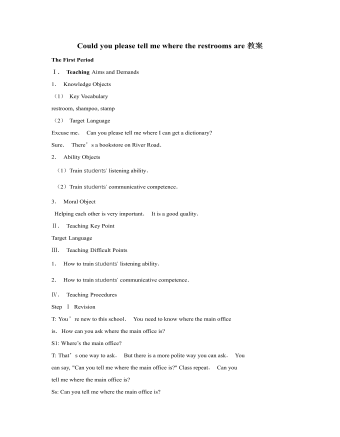
人教版新目标初中英语九年级下册Could you please tell me where the restrooms are教案
- 页数:14页
- |大小:99.00KB
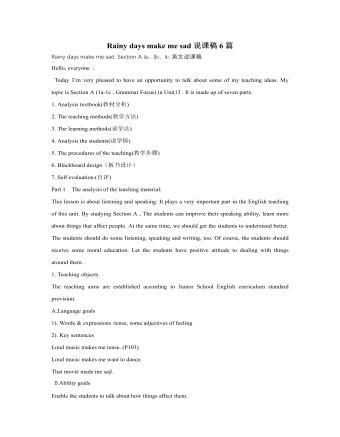
人教版新目标初中英语九年级下册Rainy days make me sad说课稿6篇
- 页数:21页
- |大小:113.00KB
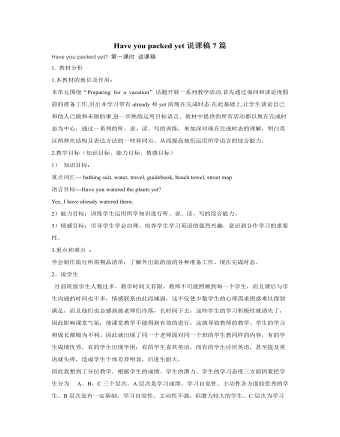
人教版新目标初中英语九年级下册Have you packed yet说课稿7篇
- 页数:41页
- |大小:192.00KB
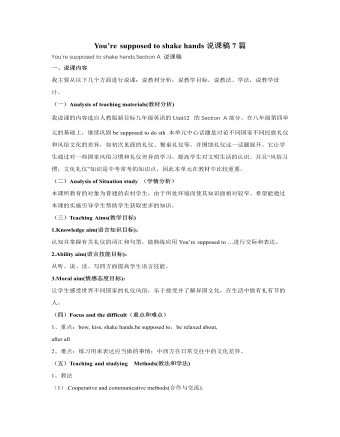
人教版新目标初中英语九年级下册You’re supposed to shake hands说课稿7篇
- 页数:20页
- |大小:107.00KB

人教版新目标初中英语九年级下册By the time I got outside, the bus had already left说课稿5篇
- 页数:17页
- |大小:112.00KB
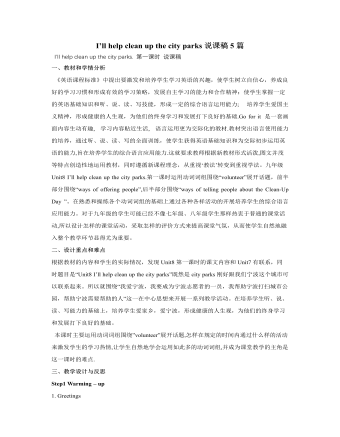
人教版新目标初中英语九年级下册I’ll help clean up the city parks说课稿5篇
- 页数:17页
- |大小:95.50KB
热门说课稿
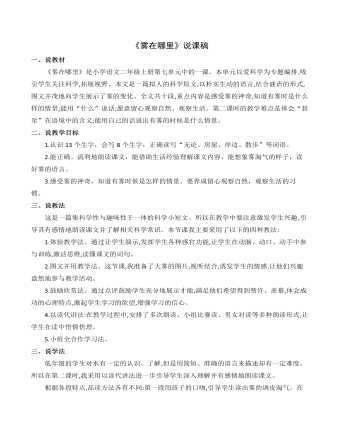
雾在哪里说课稿
- 页数:3页
- |大小:46.00KB
- 说课稿
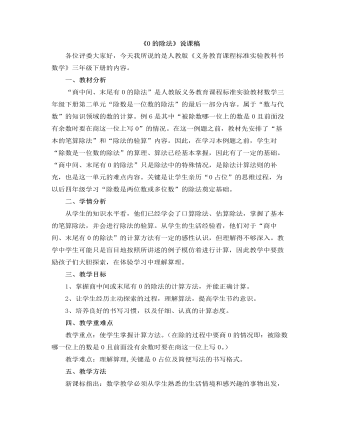
小学数学人教版三年级下册《0的除法》说课稿
- 页数:6页
- |大小:34.92KB
- 说课稿
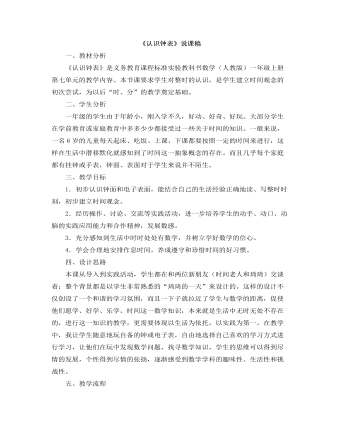
小学数学人教版一年级上册《认识钟表》说课稿
- 页数:4页
- |大小:24.27KB
- 说课稿
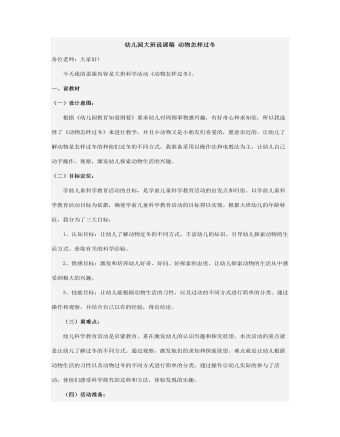
幼儿园大班说课稿 动物怎样过冬
- 页数:3页
- |大小:36.00KB
- 说课稿
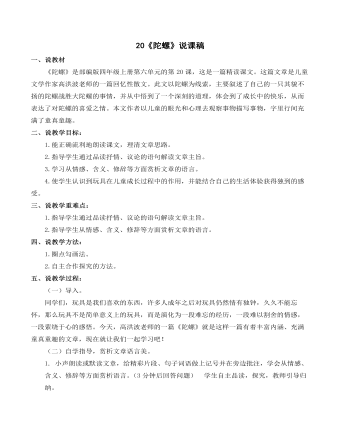
《陀螺》说课稿
- 页数:4页
- |大小:39.00KB
- 说课稿
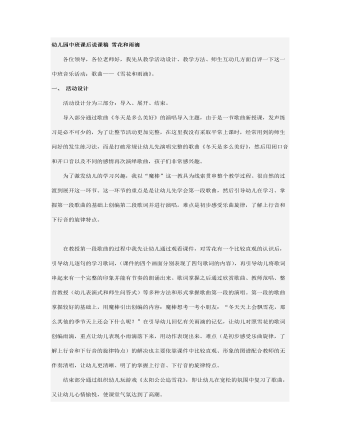
幼儿园中班课后说课稿 雪花和雨滴
- 页数:3页
- |大小:37.00KB
- 说课稿
今日更新

5月份主题教育工作情况总结汇报
- 页数:3页
- |大小:136.87KB

××县招商局2024年上半年工作总结
- 页数:12页
- |大小:142.54KB
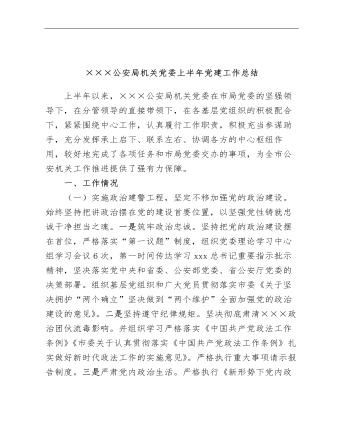
×××公安局机关党委上半年党建工作总结
- 页数:7页
- |大小:186.25KB

《2019—2024年全国党政领导班子建设规划纲要》实施情况的工作总结3800字
- 页数:6页
- |大小:29.16KB
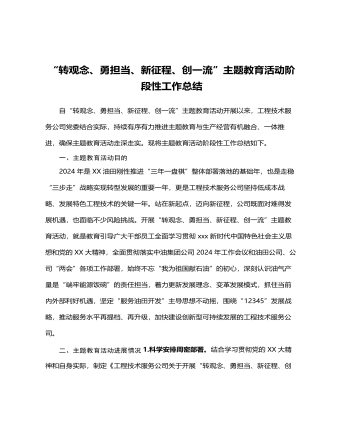
“转观念、勇担当、新征程、创一流”主题教育活动阶段性工作总结
- 页数:3页
- |大小:22.76KB

“四零”承诺服务创建工作总结
- 页数:5页
- |大小:39.83KB
